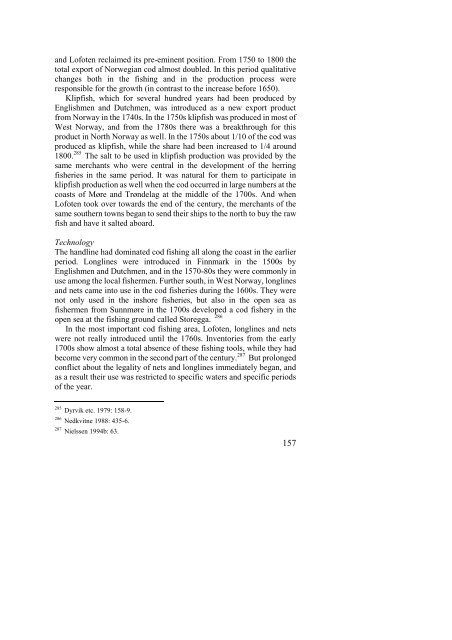The North Atlantic Fisheries, 1100-1976 - University of Hull
The North Atlantic Fisheries, 1100-1976 - University of Hull
The North Atlantic Fisheries, 1100-1976 - University of Hull
You also want an ePaper? Increase the reach of your titles
YUMPU automatically turns print PDFs into web optimized ePapers that Google loves.
and L<strong>of</strong>oten reclaimed its pre-eminent position. From 1750 to 1800 the<br />
total export <strong>of</strong> Norwegian cod almost doubled. In this period qualitative<br />
changes both in the fishing and in the production process were<br />
responsible for the growth (in contrast to the increase before 1650).<br />
Klipfish, which for several hundred years had been produced by<br />
Englishmen and Dutchmen, was introduced as a new export product<br />
from Norway in the 1740s. In the 1750s klipfish was produced in most <strong>of</strong><br />
West Norway, and from the 1780s there was a breakthrough for this<br />
product in <strong>North</strong> Norway as well. In the 1750s about 1/10 <strong>of</strong> the cod was<br />
produced as klipfish, while the share had been increased to 1/4 around<br />
1800. 285 <strong>The</strong> salt to be used in klipfish production was provided by the<br />
same merchants who were central in the development <strong>of</strong> the herring<br />
fisheries in the same period. It was natural for them to participate in<br />
klipfish production as well when the cod occurred in large numbers at the<br />
coasts <strong>of</strong> Møre and Trøndelag at the middle <strong>of</strong> the 1700s. And when<br />
L<strong>of</strong>oten took over towards the end <strong>of</strong> the century, the merchants <strong>of</strong> the<br />
same southern towns began to send their ships to the north to buy the raw<br />
fish and have it salted aboard.<br />
Technology<br />
<strong>The</strong> handline had dominated cod fishing all along the coast in the earlier<br />
period. Longlines were introduced in Finnmark in the 1500s by<br />
Englishmen and Dutchmen, and in the 1570-80s they were commonly in<br />
use among the local fishermen. Further south, in West Norway, longlines<br />
and nets came into use in the cod fisheries during the 1600s. <strong>The</strong>y were<br />
not only used in the inshore fisheries, but also in the open sea as<br />
fishermen from Sunnmøre in the 1700s developed a cod fishery in the<br />
open sea at the fishing ground called Storegga. 286<br />
In the most important cod fishing area, L<strong>of</strong>oten, longlines and nets<br />
were not really introduced until the 1760s. Inventories from the early<br />
1700s show almost a total absence <strong>of</strong> these fishing tools, while they had<br />
become very common in the second part <strong>of</strong> the century. 287 But prolonged<br />
conflict about the legality <strong>of</strong> nets and longlines immediately began, and<br />
as a result their use was restricted to specific waters and specific periods<br />
<strong>of</strong> the year.<br />
285 Dyrvik etc. 1979: 158-9.<br />
286 Nedkvitne 1988: 435-6.<br />
287 Nielssen 1994b: 63.<br />
157















